23 fun facts about Wiesbaden, Germany
If you’re a regular reader of this website, you’ll know that I recently spent some time in Germany and visited four historical thermal towns. One of them is Wiesbaden, a frequently overlooked thermal town.
Disclosure: I was sponsored on my visit to Wiesbaden by Wiesbaden Congress and Marketing. They have no influence, though, on what I write.
Another disclosure: This article contains affiliate links. If you click on an affiliate link and make a purchase, I will receive a small commission. This will not affect your price.
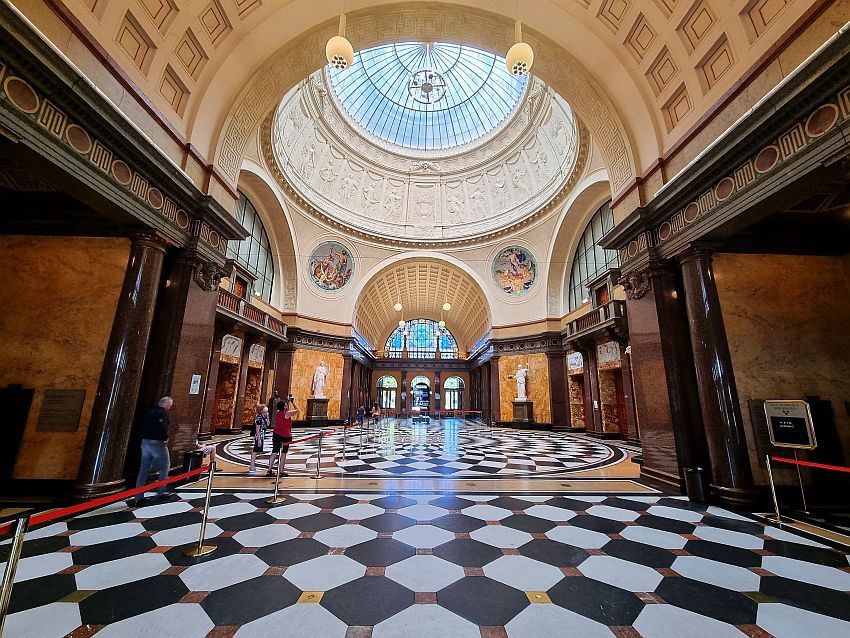
Here are some fun facts I learned while visiting Wiesbaden, Germany.
Fun facts about Wiesbaden’s thermal springs
1.They’re hot.
The water is naturally at 66°C (151°F). When exposed to air for a day or so, it turns yellowish. Romans used to dye their hair with it.
2. The water is full of iron.
There’s so much iron in the water of the Kochbrunnen on the Kranzplatz that it crusts and has to be chipped off regularly to avoid damaging the fountain. If you want to taste it, go to the round roofed fountain nearby.
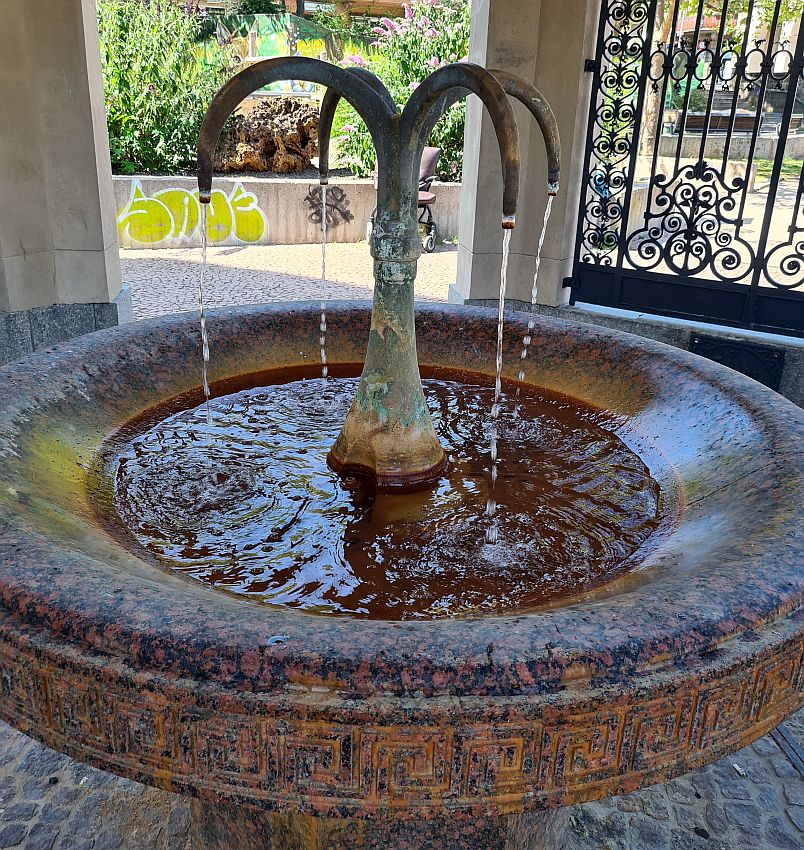
3. The water is also full of other stuff.
However, before you drink it, you should know that it contains trace amounts of things like strontium, mercury and cyanide. In small quantities, though, it won’t hurt you, and, judging by the taste – hot salty rocks, in my opinion – you’re unlikely to want more than a sip anyway.
4. There are a lot of them.
There are 26 springs!
5. The Kurhaus is big.
The massive neo-classical Kurhaus, built in 1904-1907, has a colonnade that is older, from 1827. That colonnade is the longest hall in Europe supported by pillars. Nowadays the colonnade is home to the casino’s slot machines and the Kurhaus is an events hall.
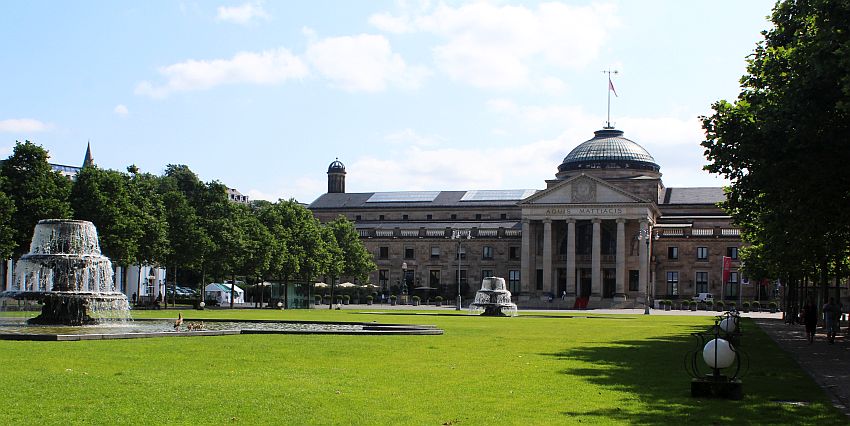
6. There’s Latin, not German, on the Kurhaus.
The Kurhaus itself hosts concerts and conventions nowadays, as well as part of the casino. The words Aquis Mattiacis on the Kurhaus mean “dedicated to the springs of the Mattiaci.” The Mattiaci were a Germanic tribe that lived here in the days when this was the border of the Roman Empire.
7. What the Kaiser wanted, the Kaiser got.
The Hessian State Theater, bordering the Kurpark, was built for Kaiser Wilhelm II in 1894 in very Neo-Baroque style. Apparently the Kaiser’s carriage could ride right into the building via a special entrance when he attended a performance.
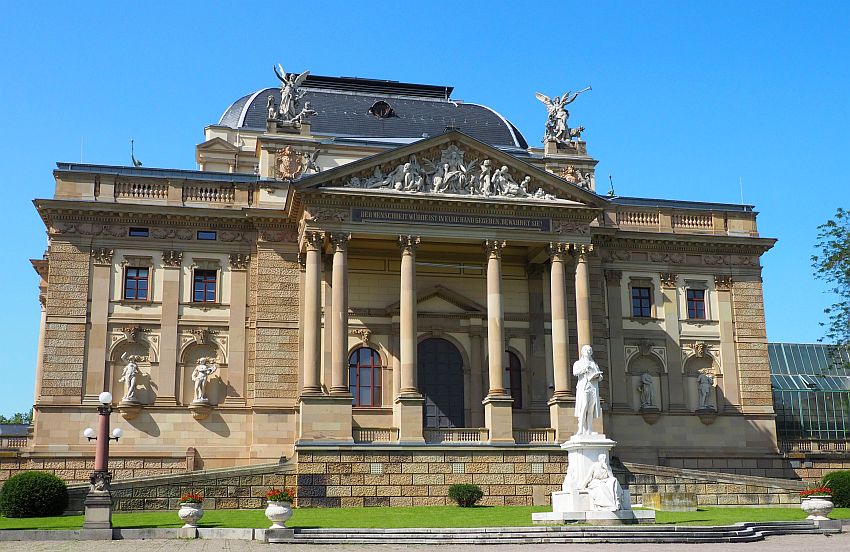
8. Wiesbaden has a Russian literary connection.
In the Kurpark, where the upper classes used to stroll in the heyday of the thermal towns, you can find a bust of Dostoyevsky in the Nizzaplätzchen. More on Dostoyevsky below.
9. You can still take the waters in Wiesbaden.
Wiesbaden has four places to take the waters nowadays. The one that dates to the height of the thermal spa town period is the art-nouveau-style Kaiser-Friedrich Therme, built in 1910-13. There, the bathing is naked and the style is Roman, i.e. with lots of pillars and arches and so forth. It has the full range of facilities: saunas and steam baths of various styles and temperatures, a tepidarium, sanarium and a “tropical freezing rain zone,” to name a few.
Set in a park, the Aukammtal thermal bath has a similar range of facilities in a more recently-built facility.
Freizeitbad Mainzer Strasse is a smaller facility, with several saunas and a swimming pool.
Opalbad is an outdoor pool with a view over the city. It also has a Finnish sauna.
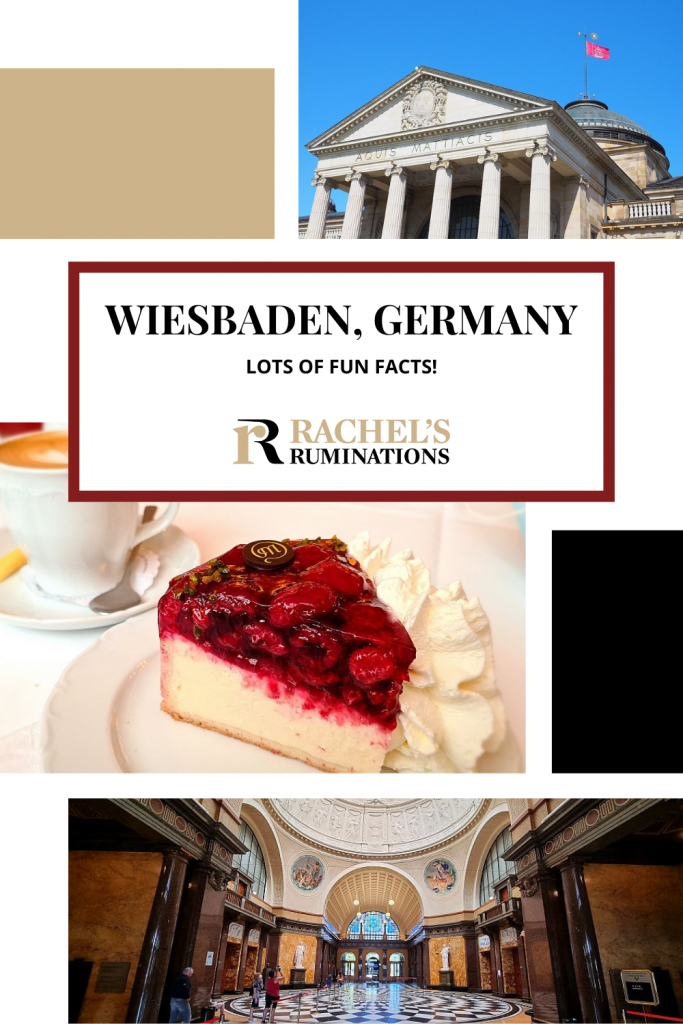
Fun facts about Wiesbaden, Germany: the town
Wiesbaden isn’t solely a thermal town. Here are some interesting facts about the town itself.
10. Despite appearances, the central church is not very old.
The very elegant red Marktkirche (Market Church) is not nearly as old as it looks. Built in 1853-62, it is a Protestant church in Gothic Revival style.
11. The statue in front of Marktkirche depicts a famous Dutch king.
The statue in front of the church is of Willem I (a.k.a. William the Silent) of the Netherlands. When he became Prince of Orange as well, he founded the Orange-Nassau branch that is the direct ancestry of the current king of the Netherlands. (As a side note, the House of Orange is why the Dutch fans at sporting events wear orange, even though the Dutch flag is red, white and blue.) Anyway, Willem I was a leader of the Dutch in the fight against Spanish rule. So why is this statue of him here, in Germany? Because he was born near here in 1533 into the House of Nassau – Nassau being the old name for this principality.
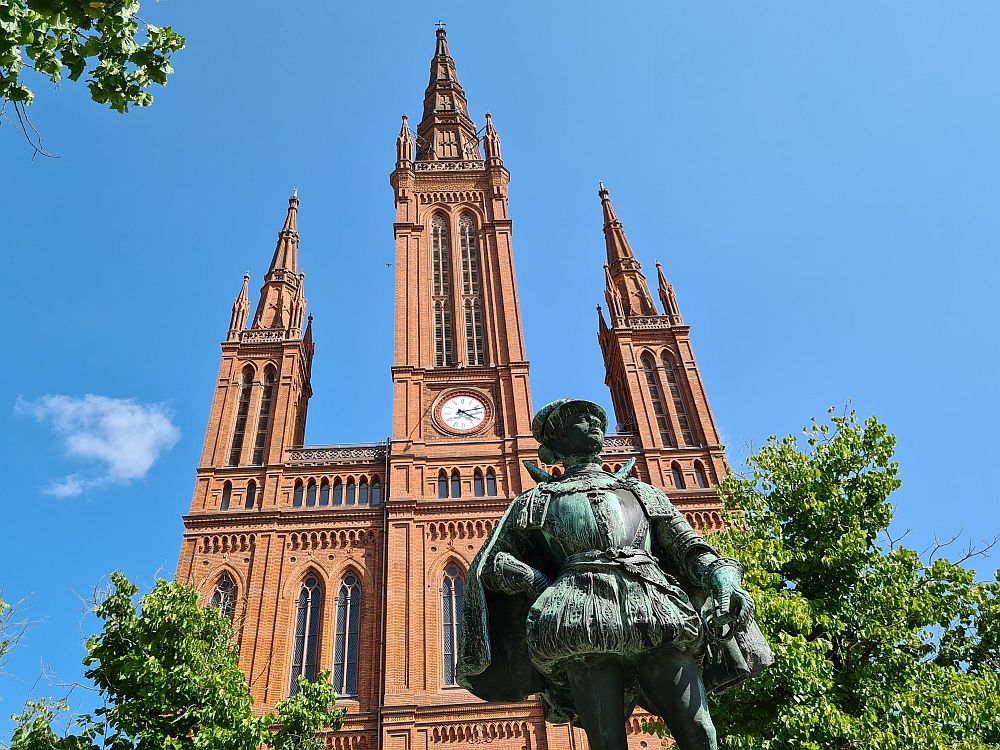
12. Art nouveau is big here.
The Wiesbaden Museum has an outstanding collection of art nouveau pieces: all sorts of furniture and other home decor as well as paintings. (It’s a very big museum with lots of other art and natural history exhibits too.) There’s also a jugendstil (German art nouveau) church called Lutherkirche on the Gutenbergplatz. The Kaiser-Friedrich Thermal bath is also art nouveau style.
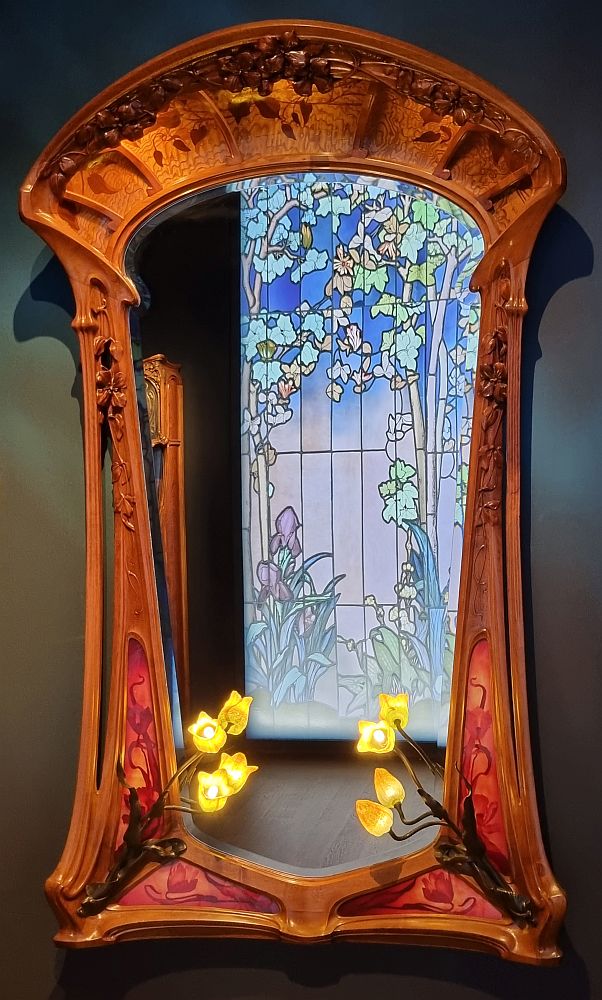
13. A cuckoo clock is big here too.
On the kitschy end of the scale, Wiesbaden is home to the world’s largest cuckoo clock, installed as an advertisement by a souvenir salesman in 1946.
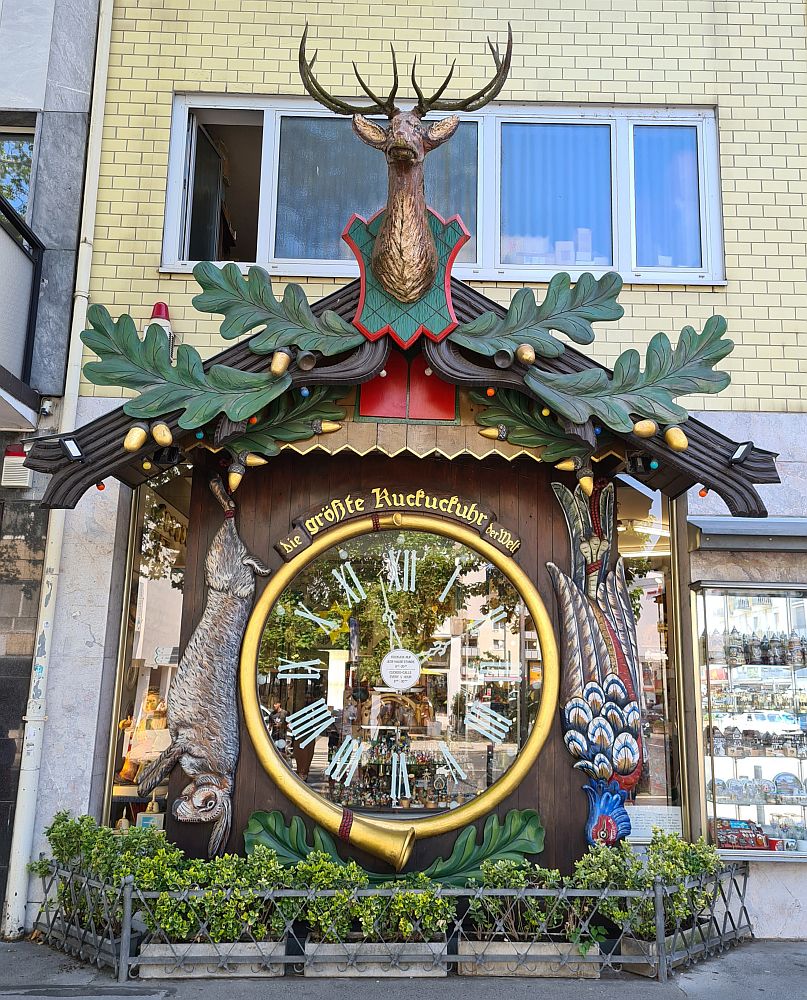
14. Wiesbaden has a villa with an American connection.
Near the Kurpark is Villa Söhnlein, built by a champagne manufacturer for his American wife. He meant it to look like the White House. Do you suppose that made her feel more at home?
15. Not that Adolf!
Adolfsallee, a pretty street lined with historic villas, is not named after that Adolf. It’s named after Duke Adolf of Nassau.
16. The funicular runs on water.
The Nerobergbahn, a funicular that takes visitors up the Nero Mountain, has been in operation since 1888. It is driven by water ballast! It has two cars, each on an end of the cable. At the top, a tank on the car is filled with water, making it heavier than the one at the bottom. That allows the upper one to pull its counterpart up the mountain. At the bottom, the water is drained from the tank and pumped up the mountain again. If you go up Nero Mountain, take a look at beautiful Russian Orthodox St. Elizabeth Church. The Nerobergbahn is the best way to get to the Opalbad as well.
17. Wiesbaden has serious Viennese pastries.
Café Maldaner in Wiesbaden is an authentic Viennese coffee house, essentially unchanged since it opened in 1859. The pastries are amazing!
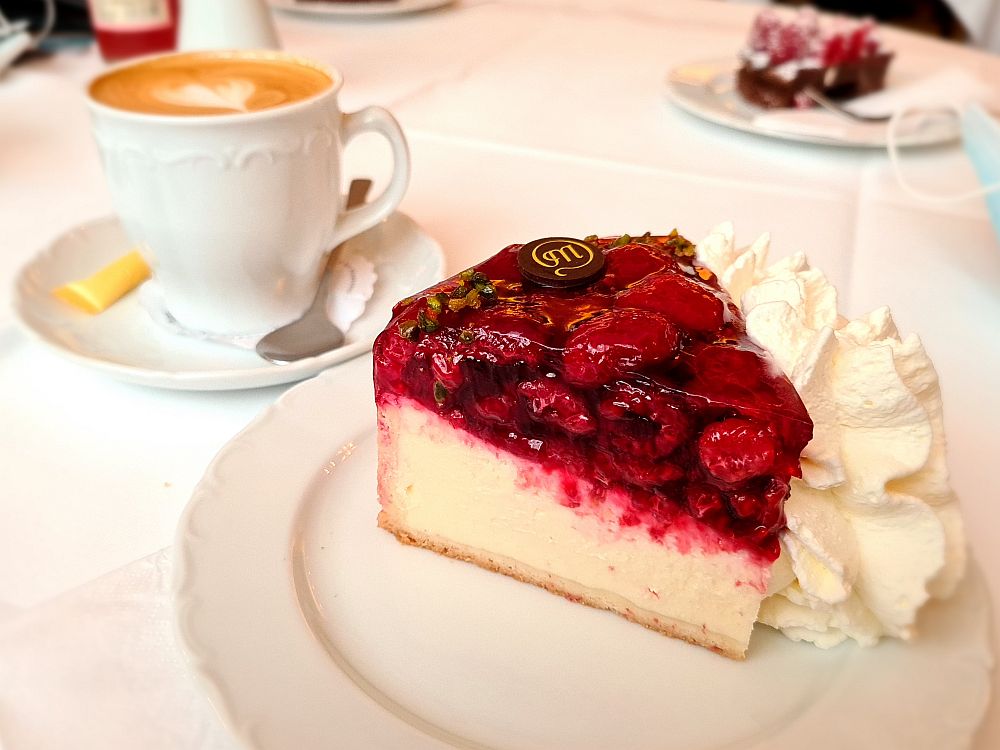
Fun facts about the hotel Schwarzer Bock
We stayed at the elegant Radisson Blue Schwarzer Bock Hotel, the grande dame of spa hotels in Wiesbaden, which has its own stories.
18. It’s old, even if it doesn’t look it.
The hotel Schwarzer Bock dates to 1486: the oldest hotel in Wiesbaden, and involved in the spa trade ever since.
19. Goethe philosophized here about taking the waters.
Goethe came here in 1818 to take the waters and wrote “The primary duty of every bather is not to sit and think, but rather to bend to a higher purpose his wit, and make a merry life of it.”
20. It has a funny name.
It got the name Schwarzer Bock (Black Bock) because the owner, Philipp zu Bock, had black hair. Bock can also mean a male goat, which probably explains why an image of a goat adorns one of the fountains in the hotel’s spa.
21. A spa of one’s own.
The hotel’s art nouveau spa downstairs, besides an indoor pool, saunas and other standard spa facilities, offers private bath cubicles – or at least it used to. The spa has been closed for a while, presumably because of the pandemic, so I didn’t get to peek in.
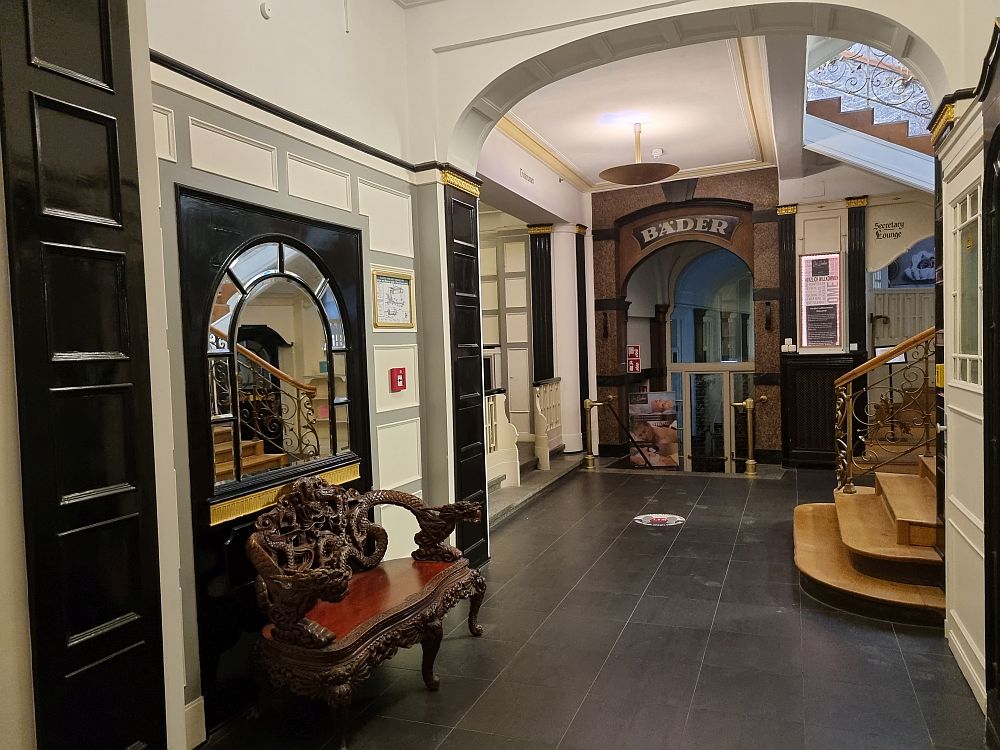
22. Dostoyevsky slept here.
He was an inveterate gambler. While he was staying in this hotel in 1865, he worked on his novel The Gambler. He lost his entire travel budget at the casino just around the corner; this was a pattern with him that we heard at other thermal towns too.
23. The hotel has its own thermal spring.
A public thermal spring – one of the originals – is accessible from the side of the hotel, but you have to ask for the key from the reception. (And it’s a pretty dingy space I wouldn’t want to spend any time in.)
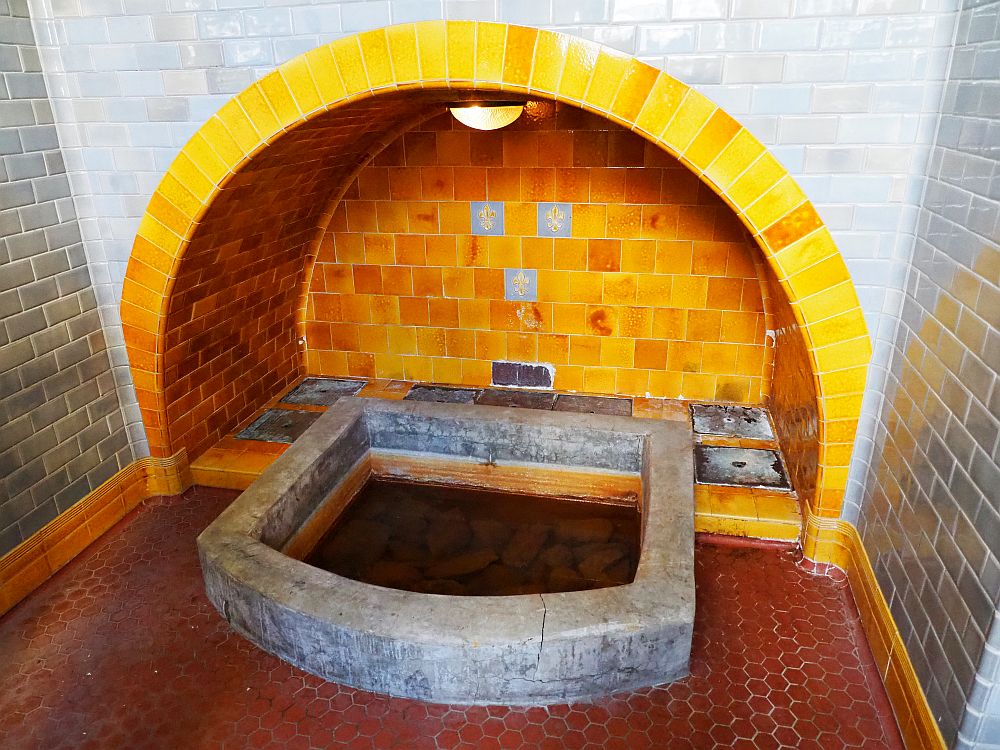
If the Schwarzer Bock is booked up or out of your price range, there are plenty of other options. Use the map below to find your accommodations.
More about Wiesbaden
Wiesbaden is a member of the European Historic Thermal Towns Association (EHTTA), an association, as the name implies, of towns all over Europe that are part of this tradition of “taking the waters.”
Wiesbaden is only an hour or so west of Frankfurt by train; even less by car if there’s no traffic. That makes it a perfect place for a day trip or weekend away.
Wiesbaden may not be as picture-perfect as Bad Ems or as well-known as Baden-Baden, but it’s certainly worth at least a short visit, whether you plan to “take the waters” or not.
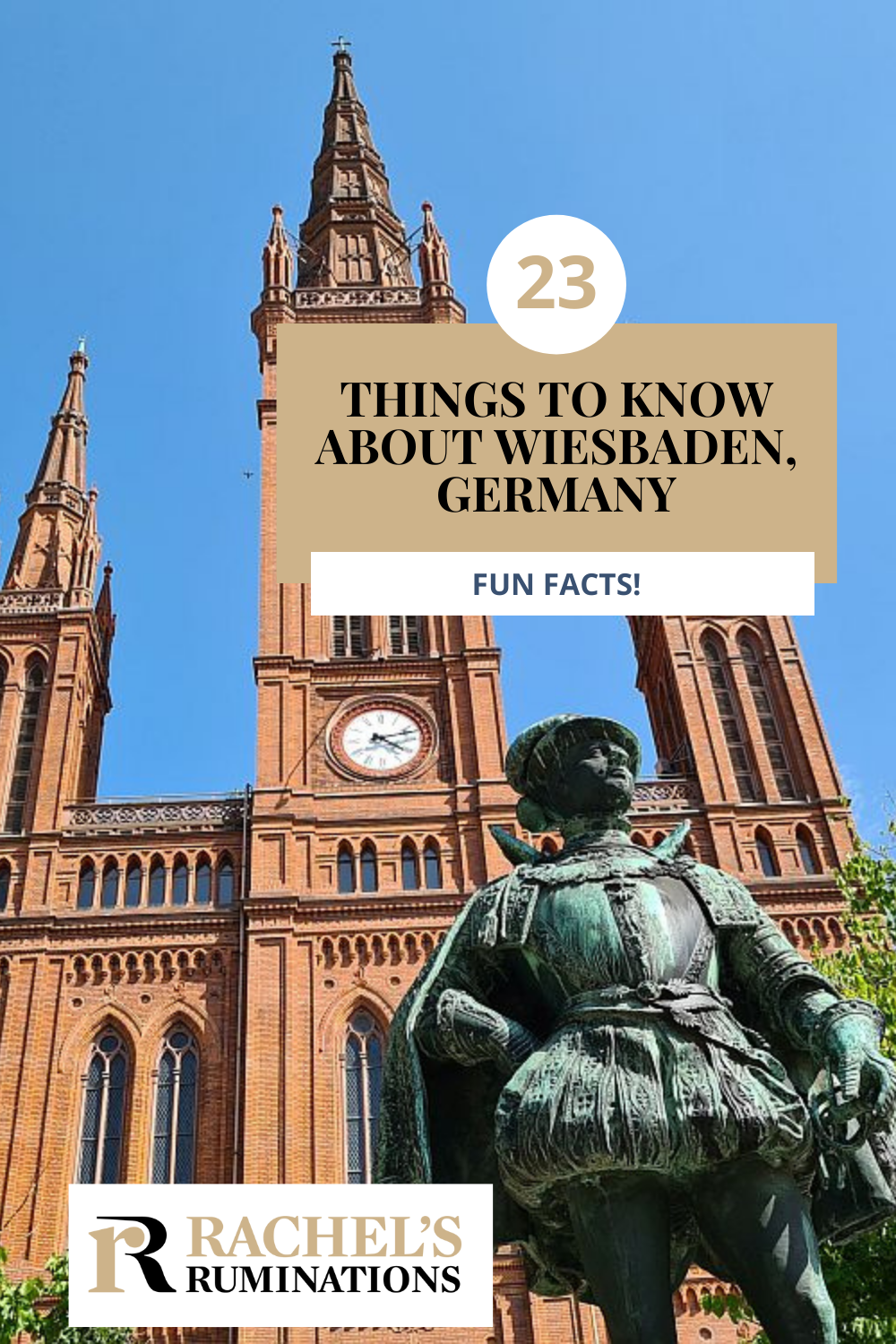
My travel recommendations
Planning travel
- Skyscanner is where I always start my flight searches.
- Booking.com is the company I use most for finding accommodations. If you prefer, Expedia offers more or less the same.
- Discover Cars offers an easy way to compare prices from all of the major car-rental companies in one place.
- Use Viator or GetYourGuide to find walking tours, day tours, airport pickups, city cards, tickets and whatever else you need at your destination.
- Bookmundi is great when you’re looking for a longer tour of a few days to a few weeks, private or with a group, pretty much anywhere in the world. Lots of different tour companies list their tours here, so you can comparison shop.
- GetTransfer is the place to book your airport-to-hotel transfers (and vice-versa). It’s so reassuring to have this all set up and paid for ahead of time, rather than having to make decisions after a long, tiring flight!
- Buy a GoCity Pass when you’re planning to do a lot of sightseeing on a city trip. It can save you a lot on admissions to museums and other attractions in big cities like New York and Amsterdam.
Other travel-related items
- It’s really awkward to have to rely on WIFI when you travel overseas. I’ve tried several e-sim cards, and GigSky’s e-sim was the one that was easiest to activate and use. You buy it through their app and activate it when you need it. Use the code RACHEL10 to get a 10% discount!
- Another option I just recently tried for the first time is a portable wifi modem by WifiCandy. It supports up to 8 devices and you just carry it along in your pocket or bag! If you’re traveling with a family or group, it might end up cheaper to use than an e-sim. Use the code RACHELSRUMINATIONS for a 10% discount.
- I’m a fan of SCOTTeVEST’s jackets and vests because when I wear one, I don’t have to carry a handbag. I feel like all my stuff is safer when I travel because it’s in inside pockets close to my body.
- I use ExpressVPN on my phone and laptop when I travel. It keeps me safe from hackers when I use public or hotel wifi.


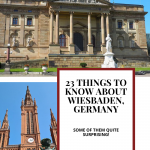
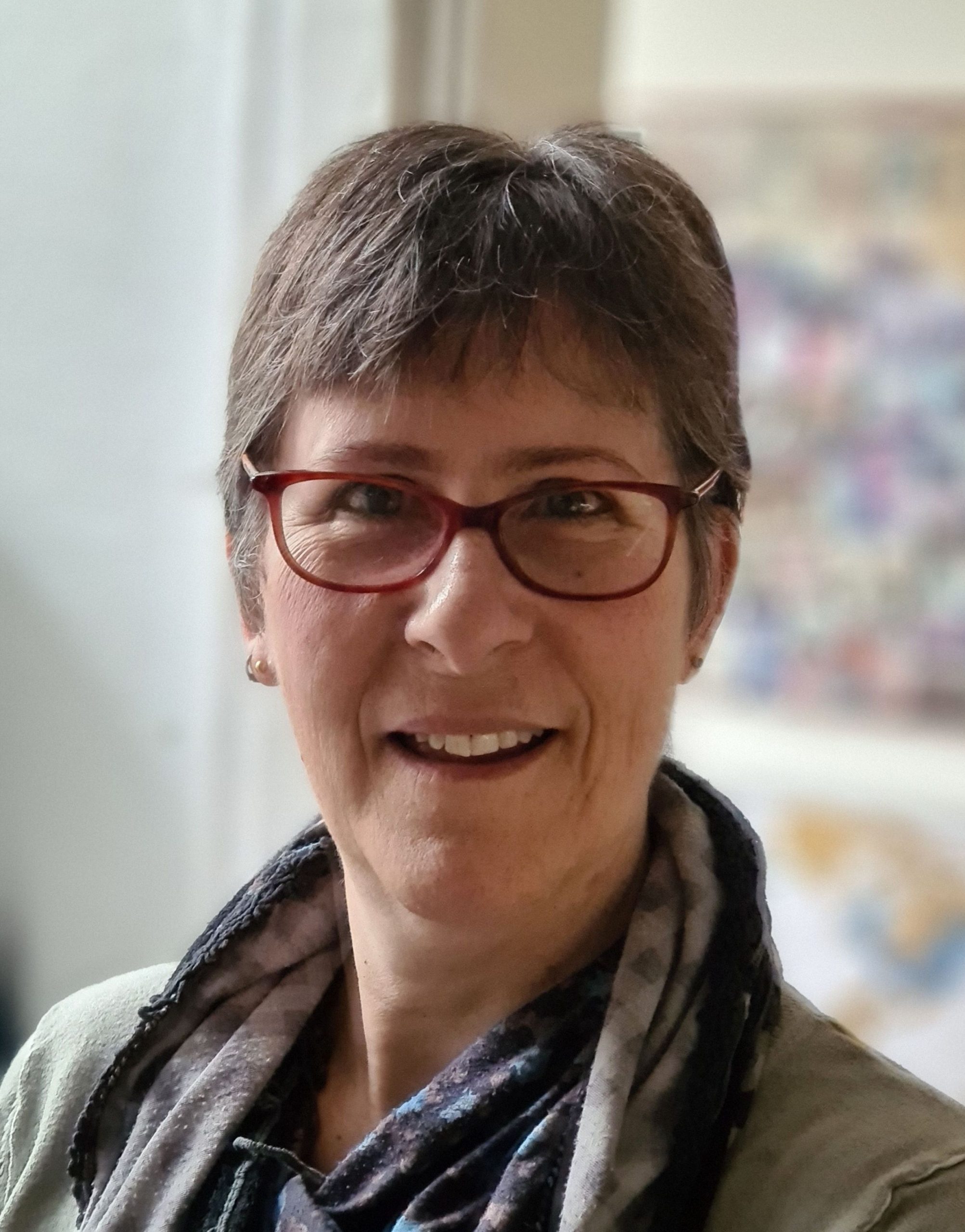
Interesting article but you got a couple of details wrong. Otherwise good job. Wiesbaden is west of Frankfurt (not east) and the catholic church is a church not a cathedral.
Thank you for the corrections! I’ve changed both points in the article.
The church shown here is the Protestant Market Church in Schlossplatz (Castle Square). The Catholic St. Bonifatius is in Luisenplatz (Louise Square), a few hundred meters away. Regards
C.E. Wagner (born and bred in Wiesbaden)
Ugh, I really try to get all the facts right! I’ll change it right away. Thanks for the correction!